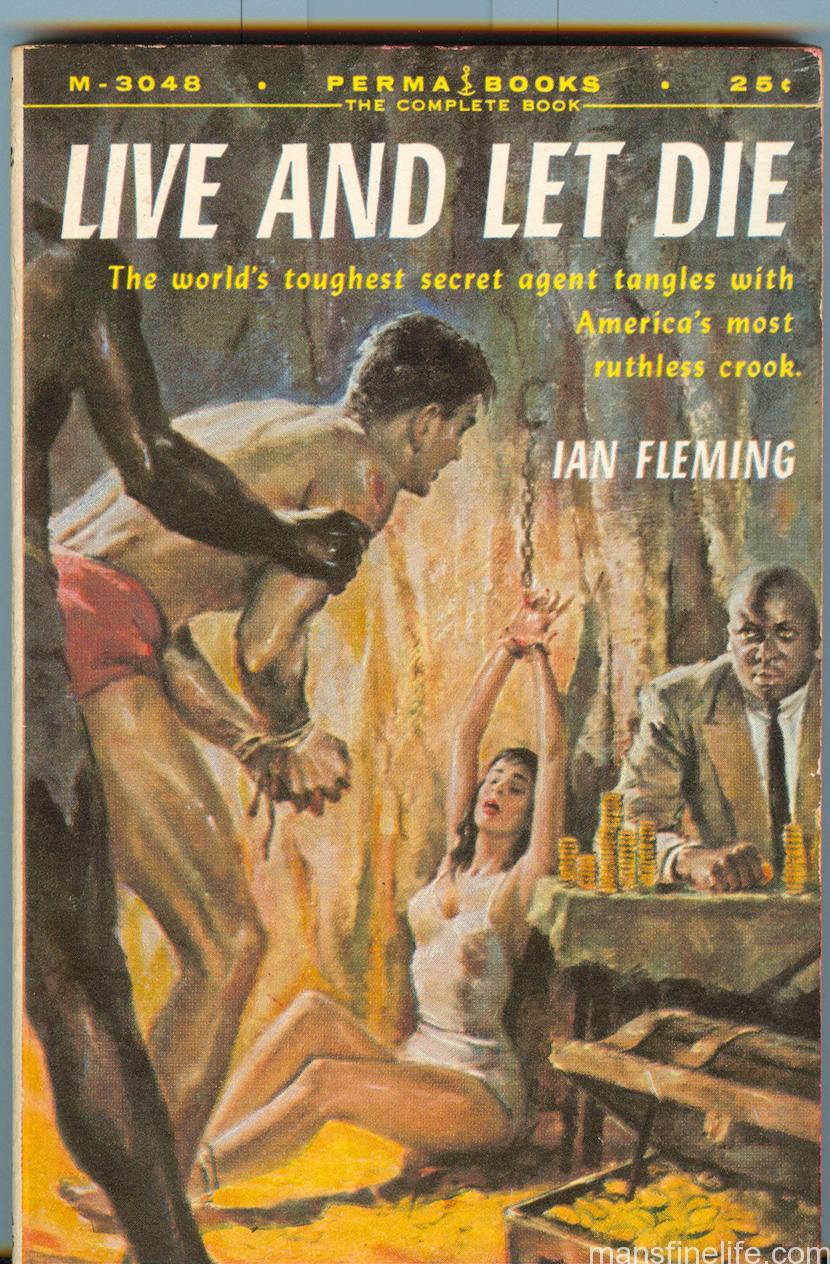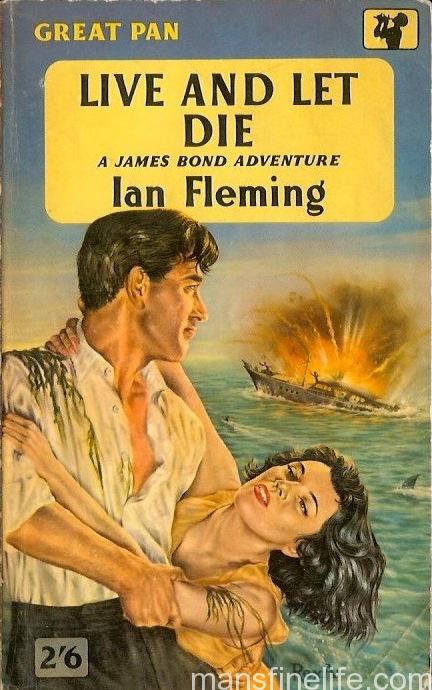Live And Let Die is the second of Ian Fleming’s legendary James Bond novels. It is also frankly the most problematic. Written in 1954 about a Caribbean crime boss wreaking havoc from his lair in Harlem and obviously penned by the most English of mid-century Englishman this side of Churchill, the writing often invokes cringe-worthy instances of political incorrectness for the modern reader. For example, while the dangerous and supremely intelligent super villain Mr. Big is erudite and possesses a genius level intellect, there are many bits of dialogue spoken by his African American underlings in rather unfortunate “Yassuh, Boss” dialect. This may reflect Fleming’s efforts at portraying colloquial English accurately but 60 years on it does not exactly hold up as the author’s best moment, not to mention Bond calling those henchmen “clumsy black apes” or the use of rude British seaman’s slang as the name for shallow coral reefs once the action shifts to Jamaica (hint: rhymes with “biggerhead”). At best the offending language is terribly dated and at worst it is extremely condescending and racially insulting.
But if we can forgive Fleming for being a man of his time and for his very English mid-20th Century views on race relations and insensitive language (which is probably much easier to do if you’re not a person of color, to be fair) then what we get when putting aside those jarring racialisms is a massive improvement in Fleming’s writing style over Bond’s debut in Casino Royale, though the latter was published just a year prior. Bond’s character has much more depth, humor and élan than in the first book and the action and adventure is crisper and more sustained, not mention the book seems much better edited so that Fleming’s more repetitive ticks have been largely jettisoned. While Casino Royale was already a very good effort, especially as a debut, Live And Let Die proves that Bond has real staying power as an iconic super spy through his character’s increased toughness and ingenuity. And certainly one doesn’t go into a Bond novel — or most of the films, for that matter — looking for a treatise on racial or feminist enlightenment. As the more modern movies would come to acknowledge, Bond is a dinosaur, a man of thoroughly 1950s outlook on women and minorities. If you can’t get over that — and it’s fine if you can’t, of course — essentially none of the original Bond novels is going to work for you. They are a guilty pleasure best enjoyed as old action books and not viewed through a modern prism any more than you would, say, a Sam Spade, Mike Hammer or Philip Marlowe adventure.
After recovering from injuries both physical and emotional sustained during the course of the brutal Casino Royale affair, Bond is summoned by M., head of MI6, to investigate the flooding of gold coins dating from the notorious privateer Henry Morgan’s era onto the black market. With the spymaster’s typical well-reasoned logic, M. theorizes that a Russian agent of Haitian descent, Buonapart Ignace Gallia, a voodoo practitioner who keeps a criminal empire running on fear and murder, aka “Mr. Big,” is pulling the strings on the elaborate plot to launder the old pirate’s treasure for nefarious ends. For Bond, who has sworn personal revenge on the Soviet assassin’s group SMERSH for their evil deeds in the Royale caper, the chance to take on Mr. Big, their key man in America, is too good of an opportunity to pass up.
Quickly, Bond finds himself in New York City, where Fleming’s love of all things American (except for the lousy coffee and fast food of the era) is ever apparent in his evocative descriptions of the fast-paced big city. Staying at the luxury St. Regis hotel in Midtown, Bond is quickly reunited with his pal from the CIA, Felix Leiter, who is to team with Bond on the Mr. Big case. (Never mind that the CIA is ostensibly prohibited from operating within US borders…) The two secret agents make the journey up to Harlem and unsurprisingly, as two extremely square, extremely white gentlemen they are quickly spotted by Mr. Big’s pervasive underground network. This leads to Bond and Leiter being captured while looking for clues at Mr. Big’s lurid exotic club, “The Boneyard.” The men are separated and Bond finds himself alone and face-to-face with the fearsome Mr. Big.
As with nearly all of Fleming’s villains, Mr. Big is something of a physical monstrosity: 6’6″ tall and 280 pounds with an enormous, oversized bald head, gray skin and bulging yellow eyes. Bond concocts a story of coming to America to aide the US Treasury in tracking the mysterious inflow of ancient gold coins but Mr. Big, as a key member of SMERSH, already has intelligence hinting at Bond’s broader plans and his Double-0 status. Mr. Big asks his kept woman, the beautiful Creole psychic Solitaire, to corroborate Bond’s cover story by reading the Tarot cards. To Bond’s surprise she does so, while also sending him unmistakable signals of alliance. As a parting warning, Mr. Big directs his henchman, the fearsomely gleeful Tee-Hee, to snap Bond’s pinky finger. Coming to after blacking out from that pain, Bond is warned by Mr. Big to go back to England and stay away from his affairs. The next time they meet, the theatrical and megalomaniacal SMERSH agent will have Bond killed in as artistically satisfying way as he, the great Mr. Big, can devise.
So begins the first third of Live And Let Die and it only picks up steam from there, with a furtive train journey down the East Coast to Mr. Big’s secretive operations in St. Petersburg, Florida; a deepening relationship between Bond and the now-fugitive Solitaire; and mortal danger for Bond, Leiter and the beautiful Creole telepath at every turn. Culminating with a masterfully tense and brutal showdown at Mr. Big’s aka Baron Samedi’s secret island hideout in Jamaica, Live And Let Die ratchets up the considerable thrills of Casino Royale with an even more sensational plot, graphic violence and detailed attention to the intricacies and dangers of spycraft by Fleming. The characters are sharper, the villain bigger and better and the second novel also introduces the globe-trotting change of locales that would come to be a hallmark of the series, both literary and filmed. If the 1973 movie Live And Let Die, Roger Moore’s debut in the iconic role, cleverly incorporated elements of the pulpy and then-popular Blaxsplotation genre, as well as inaugurating the more high-concept, sometimes wacky action era of Bond in cinema (see that speedboat chase in the bayou as well as the redneck sheriff and army of crashing police cars), the original book is more focused on finely honed observations about the power and history of voodoo, how a huge criminal enterprise might successfully operate in the United States under cover of small time crime and the ingenious and ruthless methods deployed by the criminal mastermind involved. In short, it’s a ripping yarn full of dynamic changes of pace, hard-nosed detective work, camaraderie in the face of danger and memorable bursts of ultra-violence. Fleming’s gift for the sudden shock and the unexpected upping of stakes continues to evolve nicely, leaving one primed and ready for the apocalyptic possibilities of his third Bond adventure, Moonraker. Tune in next time to see how that one stacks up.






